Ahlam Shibli’s Occupation
Introduction by Ulrich Loock
Every single photograph of the work is permeated by the violence that the Israeli state exercises against the people of al-Khalil/Hebron, and all of the Palestinian people, in the occupied West Bank—through both the settlers it supports and its military. If Ahlam Shibli’s Occupation (2016–17) is to be considered within the context of postcolonial discourse, it would have to assume a particular position in that field as it traces the effects of a crude and primary colonialism. In the series of thirty-two photographs taken over two years in al-Khalil, Shibli focuses on marks the occupation has left on the city’s urban architecture. An overview photograph of al-Khalil offers visual evidence of the disruptive force of Israeli intrusion into the old city center; the rundown exterior of a Palestinian school features a staircase that is caged in to protect the pupils against stone-throwing settlers, while the ideological justification for Israeli settlers’ appropriating Palestinian territory can be found in a painting on a metal wall blocking off a street—the mural depicts two men carrying a huge cluster of grapes, referring to the Biblical account of the Israelites first taking possession of the land of Canaan.
While Shibli’s work leaves no doubt about the profound destruction of Palestinian livelihood, the photographs do not function as a representation of the dynamics of occupation, neither its causes nor its workings. Her images do not expose the perpetrators, do not depict scenes of abuse, do not show the most oppressive military installations. Thus her photographic series might not even appear to be part of the struggle against the colonial power. Instead, her images isolate moments of tranquility; the action is over. The photographs present views of a place locked in a time after the passing of time. The violence of settlers and the military, the suffering of the Palestinians, all appear bracketed—however engrained in private and public space alike.
Shibli emphasizes that she photographs what she sees in a given place and time. Recording what is there, she becomes immersed in the situation and yet, at the same time, keeps a specific distance. Afterwards, when editing her pictures to build a work like Occupation, Shibli refuses to rely on single photographs and prefers a cinematic sequence of images to expose the issue at stake. Nevertheless, the images do not form a narrative. Instead they might, in a certain way, tend to appear repetitive, as different as they are. Only rarely do living beings make an appearance; they are like strangers in an environment of devastation. Most of the few persons depicted in Occupation are children, though one photograph shows pigeons that a man breeds in the house he had to give up in order to escape harassment by settlers. It may be that Shibli avoids including people in the majority of her images for reasons to do with preserving their dignity—so as not to show the traces of abuse on their bodies. Still, the children she depicts display an air of concentration and serenity nonetheless.
As al-Shaykh Ghūmah said, “Read the signs.” The out-of-time quality of what is seen coincides with seeing what is not to be seen. It may appear revolting that in Occupation the pictures from the localities of the settlers resemble the pictures from the localities of the Palestinians. Those who justify the occupation of the Palestinian city by claiming that they are taking back the Promised Land have established themselves in prisonlike spaces, including the colorful playground designed for the settlers’ children. Palestinians, on the other hand, have adopted the hardware used by the occupation forces to enclose themselves in their homes. Shibli’s photographs present a profound unsettling of the assumed relations between the oppressor and the oppressed: both appear compelled to subject themselves to alienating conditions of submission and self-limitation. Only the children in some of the photographs seem to be somehow exempt from this drive.
What is there, what is not supposed to be seen, is manifested through an abundance of colors and details; sensuous richness reveals the artist’s objection to the disasters of the occupation.
▪
All the calamity of the occupation is concentrated in al-Khalil.
—Imad Hamdan, Director, Hebron Rehabilitation Committee
The foundation of Occupation (2016–17) is the destruction of Palestinian livelihood in al-Khalil/Hebron and the occupied territories by the Israeli colonial regime and Zionist settlers. The occupation, specifically the settler invasion, subjects the city of al-Khalil to continuous measures of adverse territorialization that are implemented and controlled by multiple types of checkpoints, walls, fences, barriers, surveillance cameras, rules, and orders. The photographs of Occupation trace the ways in which the settlers and the Palestinian population live in an asymmetrical relationship in al-Khalil, bound together in the limited space of the Old Town and confined to an environment defined by physical borders and perverse regulations.
The photographs record the signs of a disturbing duplicate inversion, among other things. On the one hand, the images indicate how the settlers—who have invaded the Palestinians’ territory, preventing them from using their property, and disrupted their freedom of movement—create a prisonlike space for themselves. On the other hand, the photographs reveal how the Palestinians use the hardware of the separation implemented by the Israeli occupation—sheet metal, razor wire, barrels filled with cement, fences, grids, nets, et cetera—to protect their own public spaces and their homes. It is as if the occupation had succeeded in making them occupy themselves, or as if the Palestinians were internalizing the effects of the imposed barriers by creating ever more of them on their own.
—Ahlam Shibli
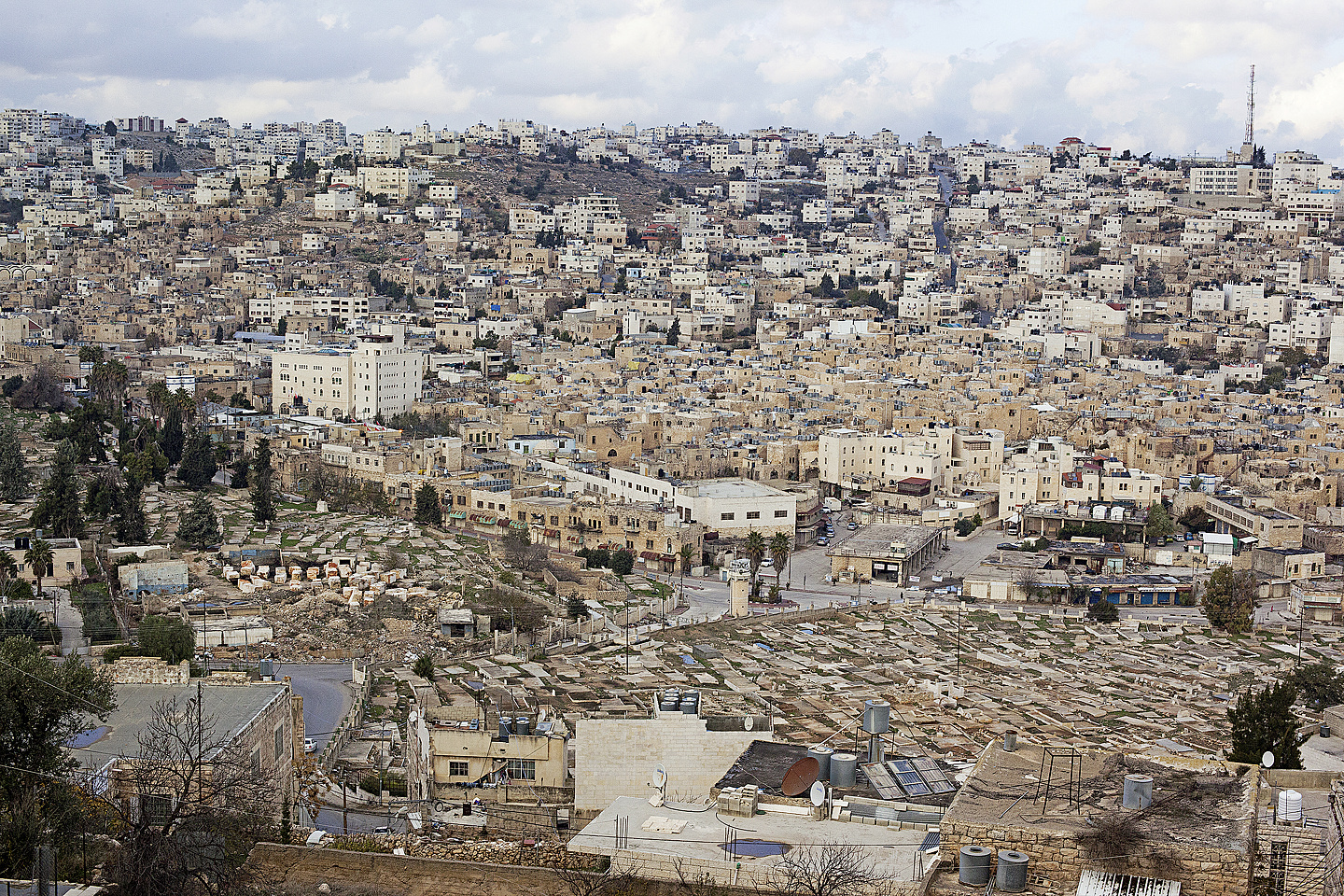
Untitled (Occupation no. 1), al-Khalil, Palestine (2016–17), chromogenic print, 100 × 150 cm. Islamic cemetery, al-Shuhada Street, Hay al-Yahud/Avraham Avinu settlement, Old Town, northern part of the city, al-Khalil, December 25, 2016
View from al-Rahma hill. Jews have free access to al-Shuhada Street; Palestinian access is limited to residents who are registered by the Israel Defense Forces (IDF) at the checkpoint, but only on foot. They have to renew their registration every year. All Palestinian shops in al-Shuhada Street and in Hay al-Yahud/Avraham Avinu settlement are closed by Israeli military order. Most of the Palestinian houses are deserted due to constant harassment by the IDF and settlers.
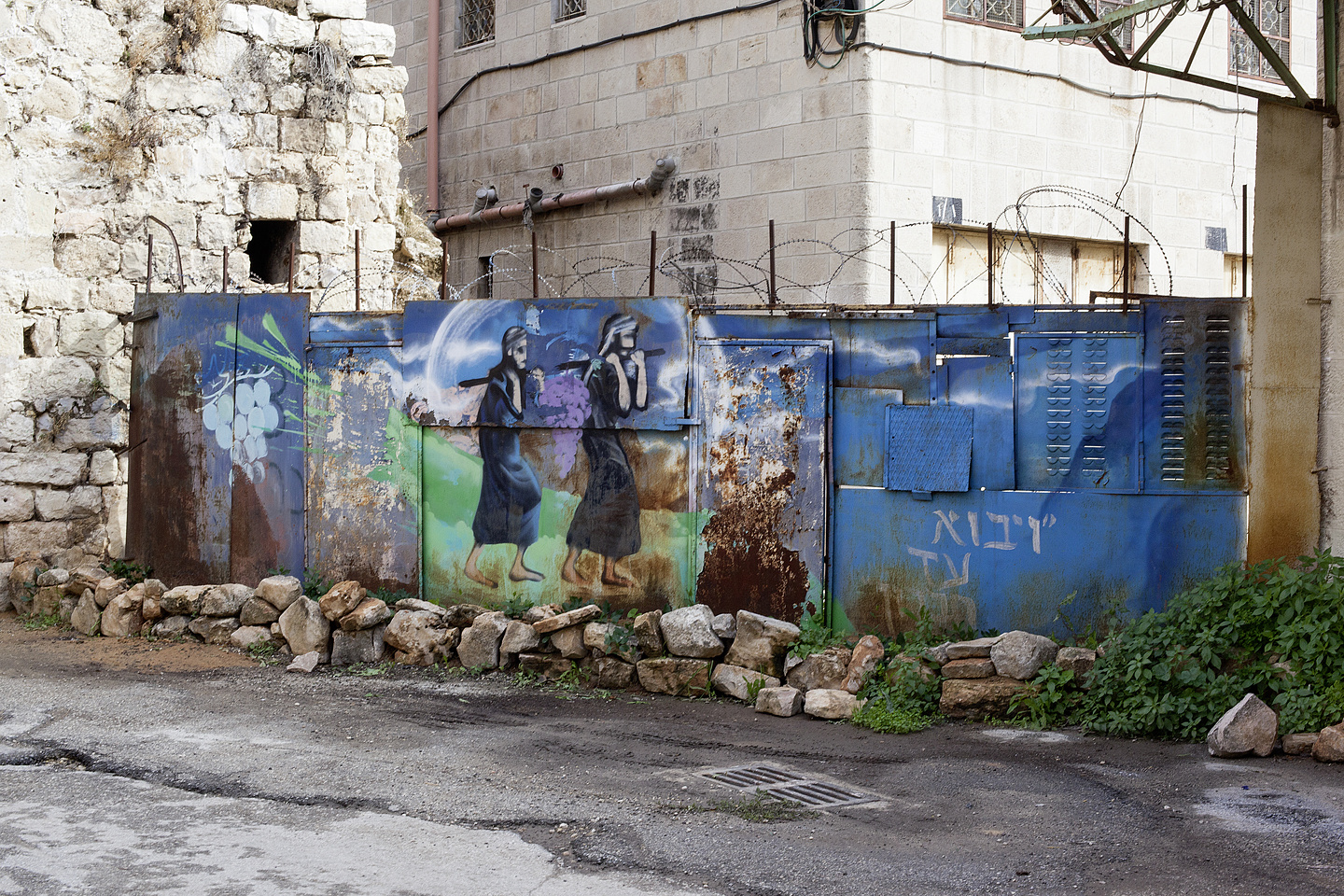
Untitled (Occupation no. 4), al-Khalil, Palestine (2016–17), chromogenic print, 40 × 60 cm. Bab al-Khan Street, Hay al-Yahud/Avraham Avinu settlement, Old Town, al-Khalil, December 21, 2016
The IDF blocked Bab al-Khan Street before the Second Intifada. Since 2001, Palestinians have had no access to either side of the road, and the entire area is surrounded by Israeli checkpoints and blocked roads with the exception of the roads connecting the settlements. The painting on the metal wall showing two men carrying a large cluster of grapes refers to Numbers 13: “(1) And the LORD spake unto Moses, saying, (2) Send thou men, that they may search the land of Canaan, which I give unto the children of Israel … (22) And they ascended by the south, and came unto Hebron; where Ahiman, Sheshai, and Talmai, the children of Anak, were. (Now Hebron was built seven years before Zoan in Egypt.) (23) And they came unto the brook of Eshcol, and cut down from thence a branch with one cluster of grapes, and they bare it between two upon a staff.”
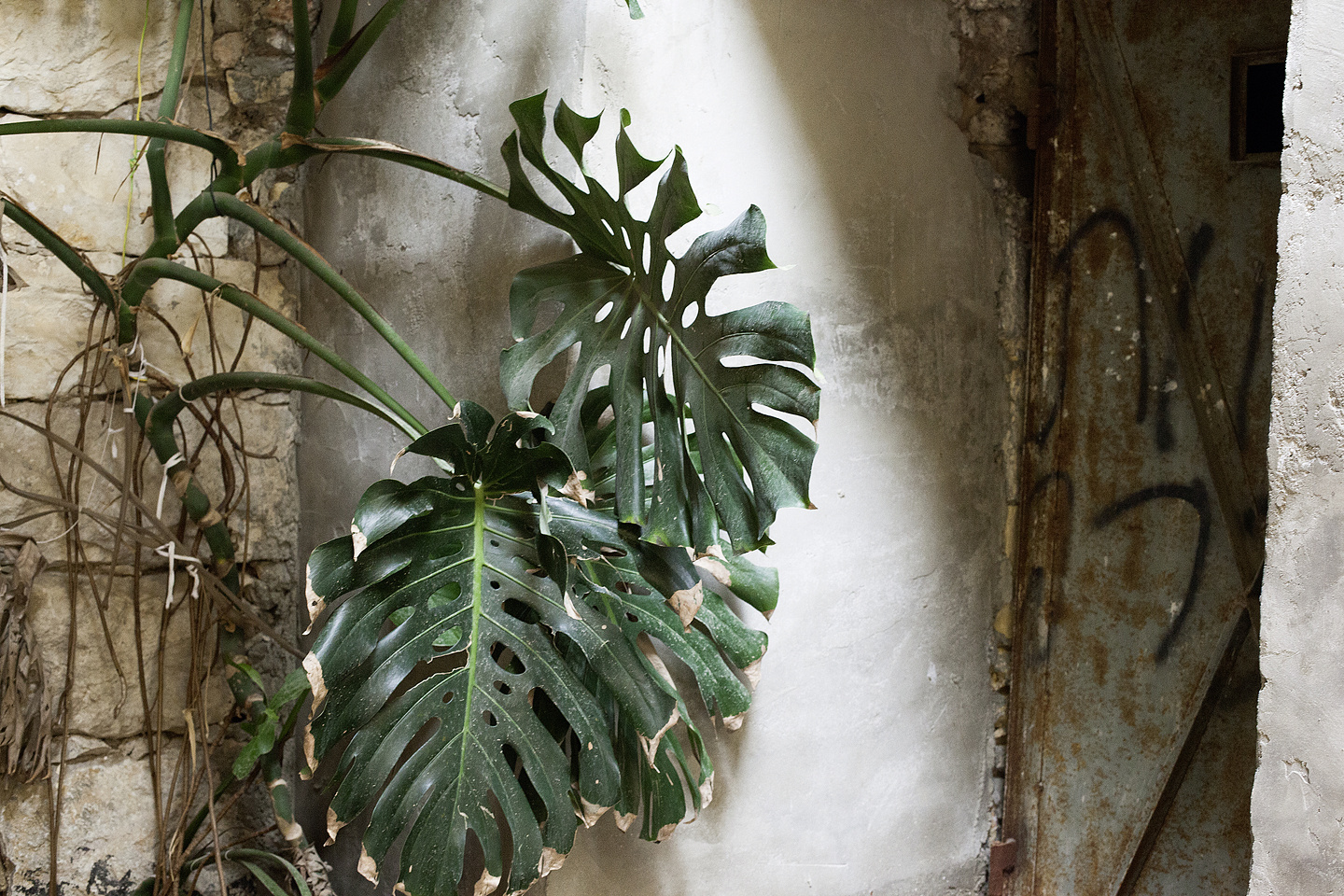
Untitled (Occupation no. 5), al-Khalil, Palestine (2016–17), chromogenic print, 26.7 × 40 cm. House of the al-Sharabati family, Hay al-Yahud/Avraham Avinu settlement, Old Town, al-Khalil, December 21, 2016
In 1979, under the protection of the IDF, settlers arrived with bulldozers to tear down the old Jewish houses in Hay al-Yahud, the Jewish neighborhood, in order to construct new buildings for additional settlers, thus creating the Avraham Avinu settlement. During this operation they destroyed parts of the houses of the al-Sharabati and Bader families. The families were expelled from their houses in July 2002.
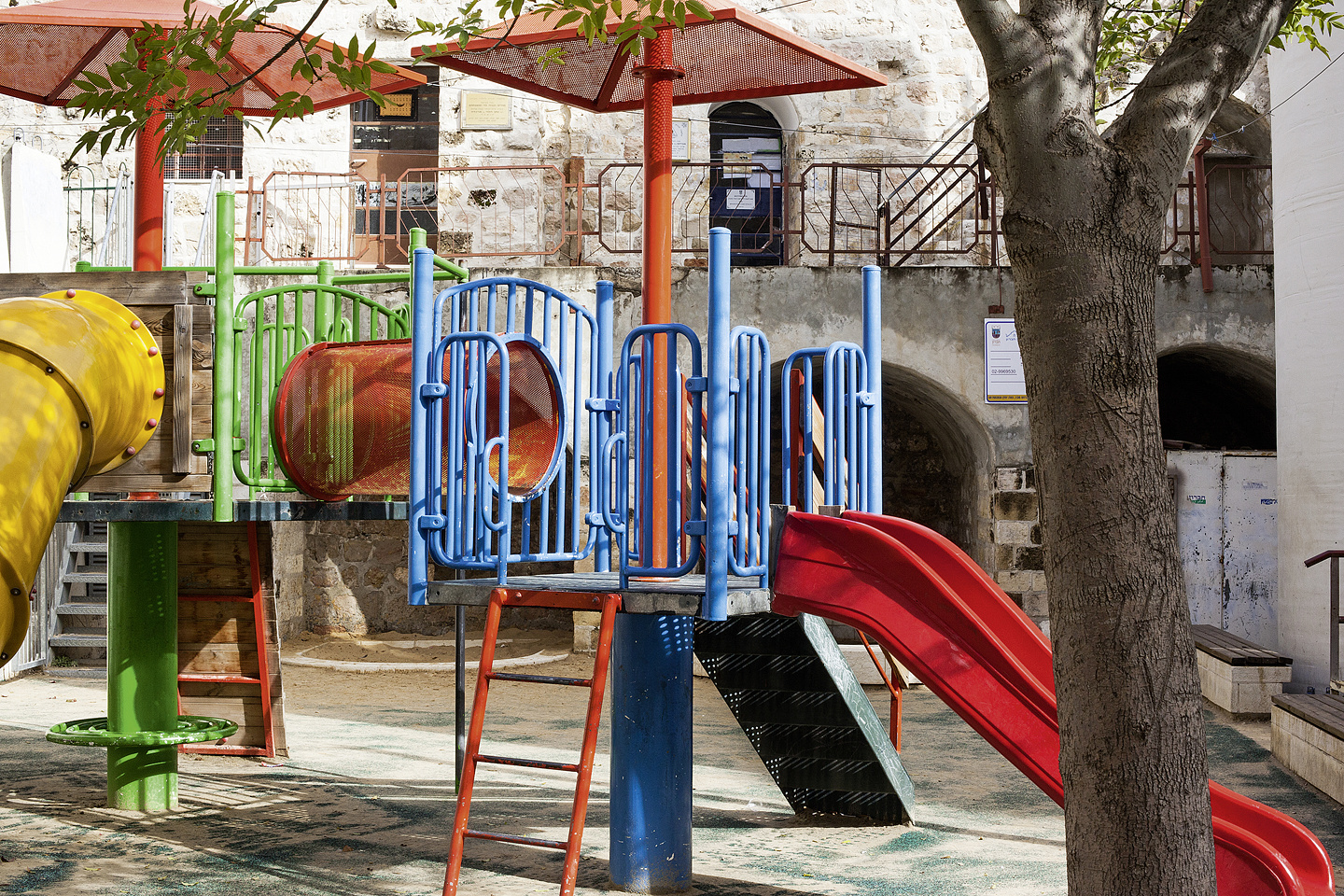
Untitled (Occupation no. 6), al-Khalil, Palestine (2016–17), chromogenic print, 40 × 60 cm. Playground, Souq al-Haddadeen, Hay al-Yahud/Avraham Avinu settlement, Old Town, al-Khalil, December 21, 2016
The wall behind the playground of the settlement is the backside of Palestinian blacksmiths’ shops and several offices on the upper floor, all closed in 2001 by order of the Israeli military. Palestinians are absolutely prohibited from entering the area of Souq al-Haddadeen (blacksmiths’ shops). The settlers opened the workshops from the back to enlarge the area of the playground; they use the spaces on the top floor as their community offices.
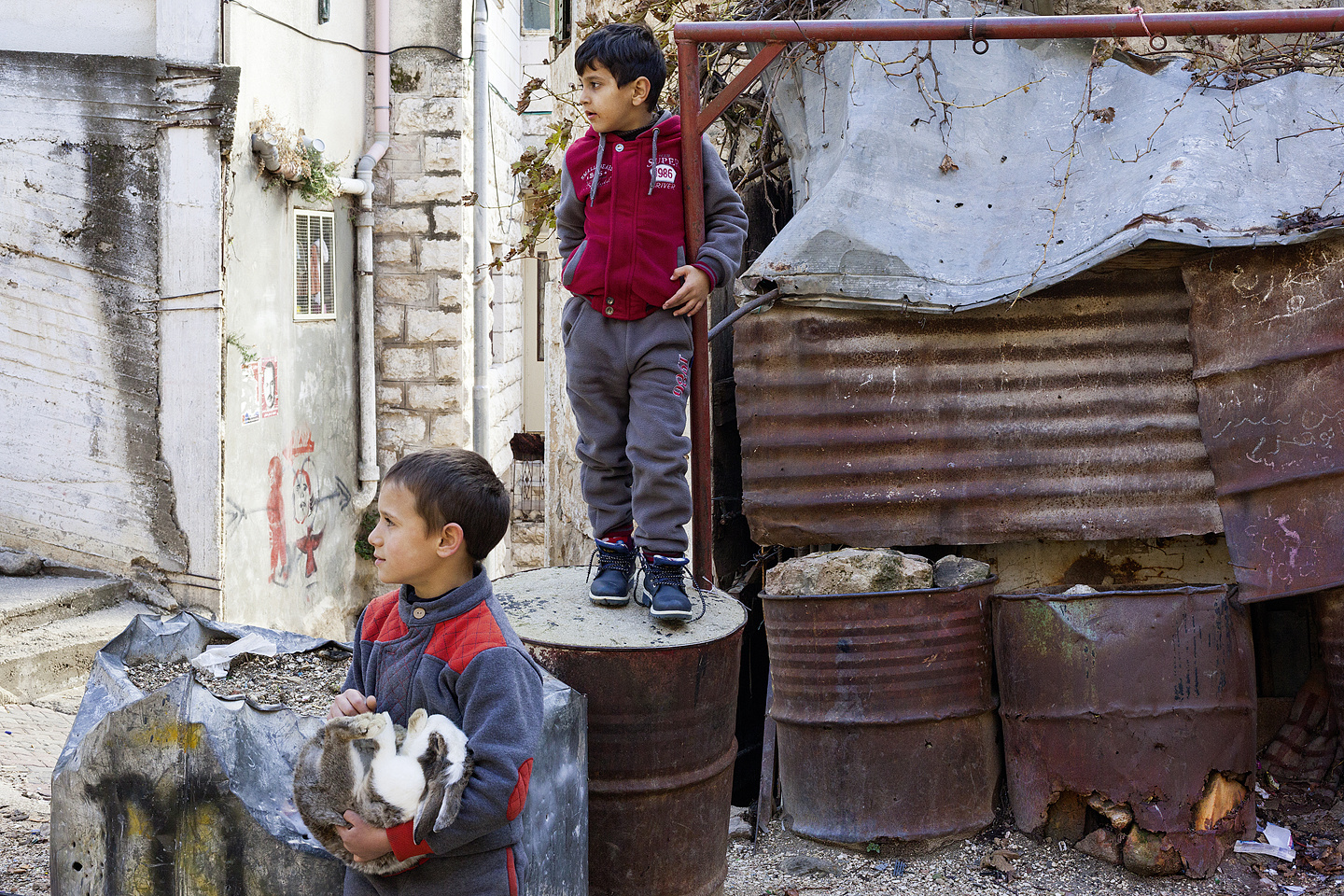
Untitled (Occupation no. 15), al-Khalil, Palestine (2016–17), chromogenic print, 40 × 60 cm. ‘Ain al-Qurneh neighborhood, Old Town, al-Khalil, December 20, 2016
Families use metal barrels and containers filled with stones, debris, and concrete to separate their properties from their neighbors’.
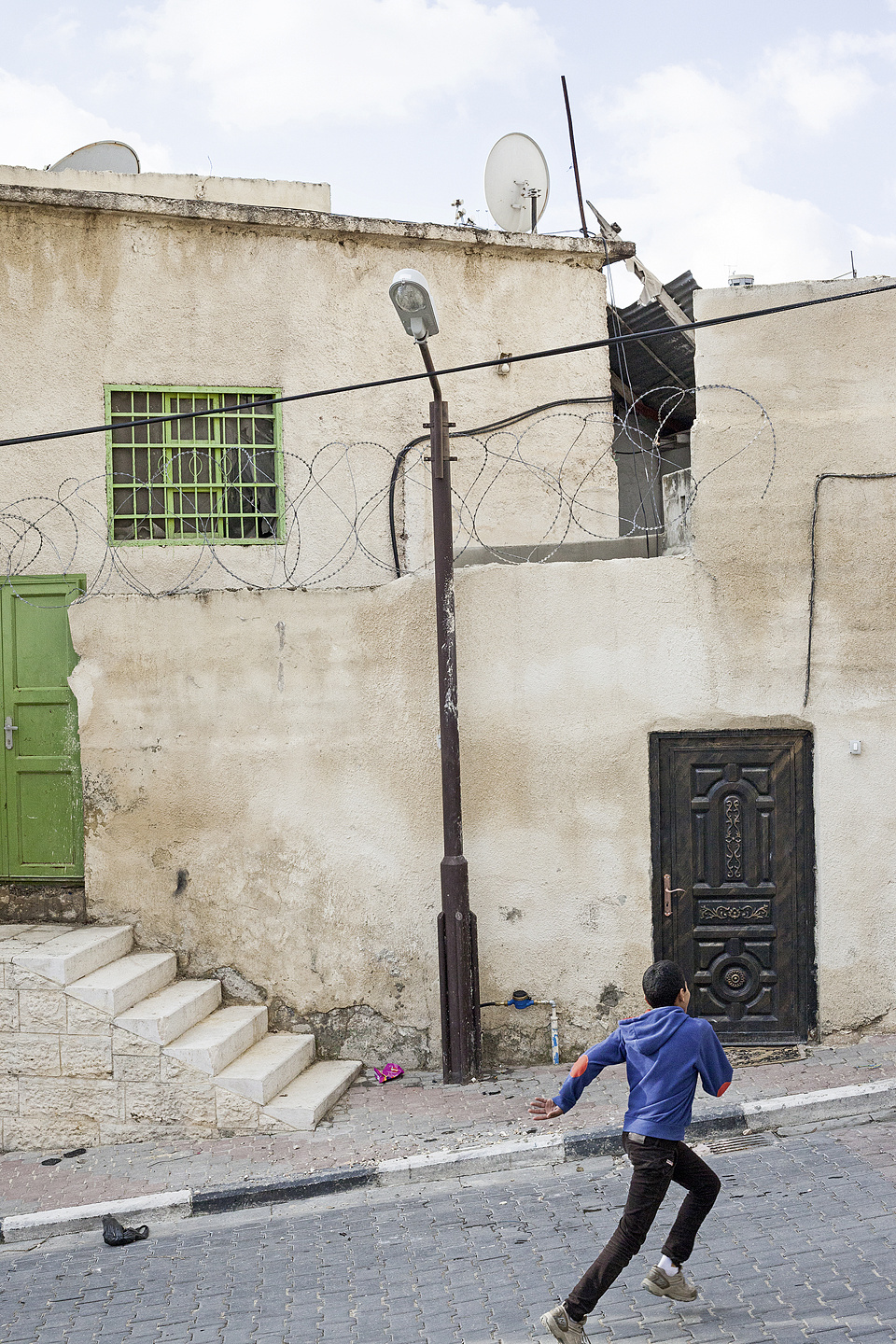
Untitled (Occupation no 17), al-Khalil, Palestine (2016–17), chromogenic print, 60 × 40 cm. Khallet Hadour Street, Old Town, al-Khalil, December 20, 2016
A family installed razor wire on top of their wall to prevent people from climbing over. Due to the serious injuries it can cause, this wire has a strong psychological effect on people. Usually this kind of wire is under tension and, when cut, it recoils, unrolls, lashes out, and strikes the person cutting.
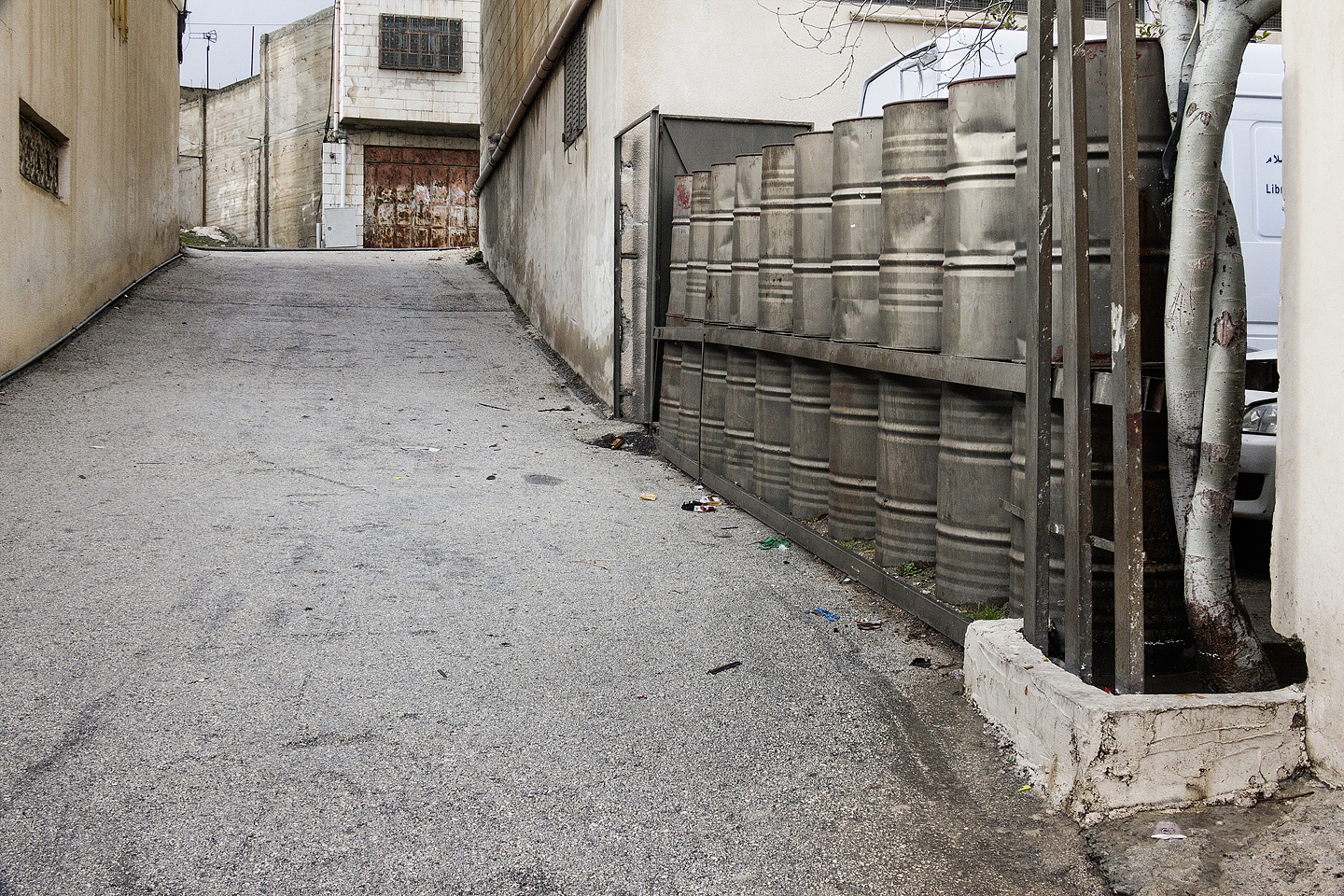
Untitled (Occupation no. 18), al-Khalil, Palestine (2016–17), chromogenic print, 40 × 60 cm. Residential building of the al-Rajabi family, Tareq ben Ziyad Street, al-Mashrqa al-Tahta neighborhood, Old Town, al-Khalil, January 27, 2017
The family blocked the entrance to their yard from the byroad of Jabal al-Rahmah that leads to an important road for settlers. The settler road connects all settlements in the city, and only settlers are permitted to drive on it. All other streets leading to that road have been blocked with concrete blocks, metal structures, or barrels by the Israeli army. Entire Palestinian neighborhoods are affected by these closures.
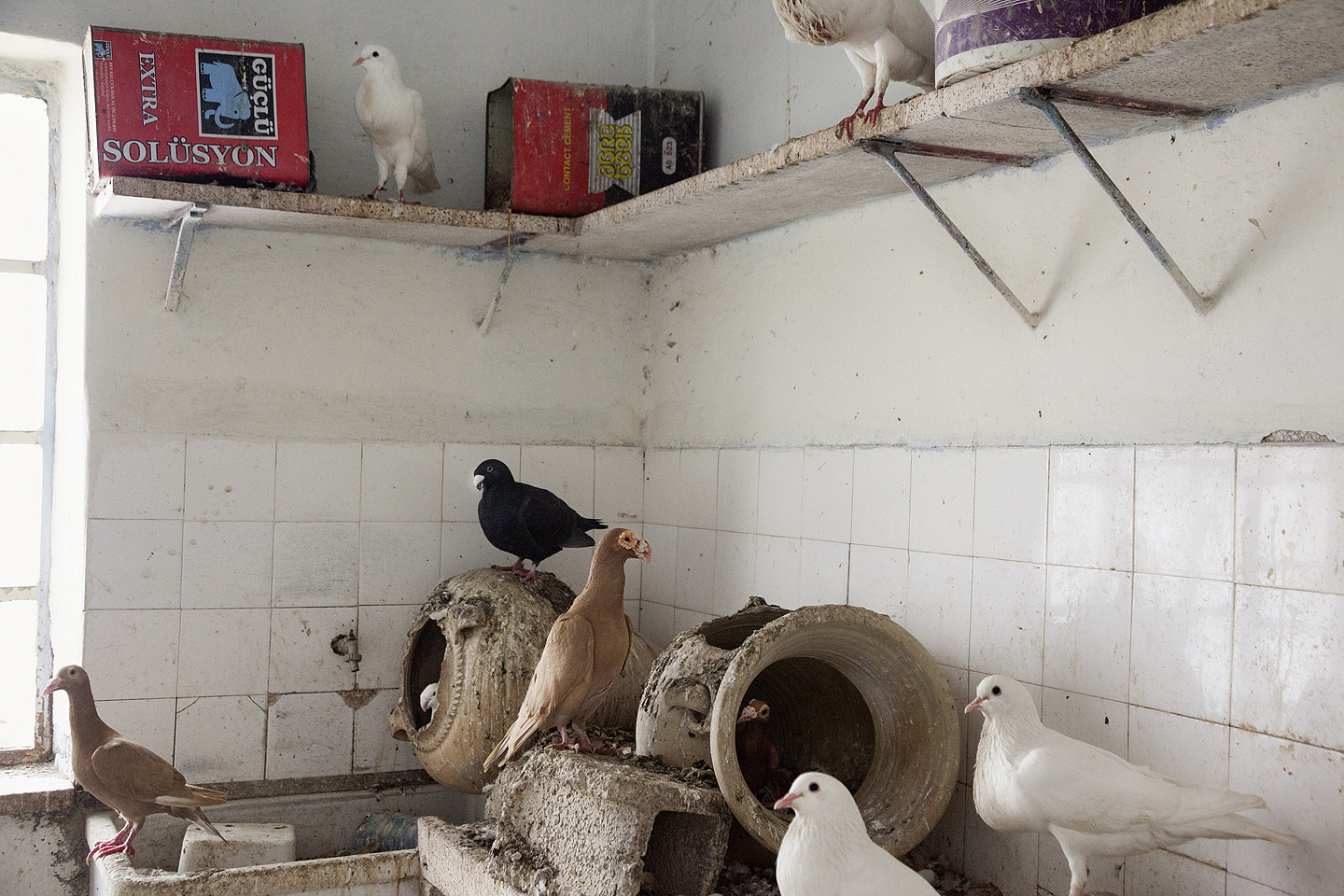
Untitled (Occupation no. 21), al-Khalil, Palestine (2016–17), chromogenic print, 26.7 × 40 cm. Old house of the Sufyan al-Ja’abari family, al-Tullab Street, al-Khalil, January 25, 2017
Sufyan breeds pigeons and goats in his family’s old house. The settlement Giv’at Ha’avot adjoins the family house and includes the Israeli Ja’abrah prison and police station. Both are used against Palestinians as well as Israeli activists who oppose the occupation.
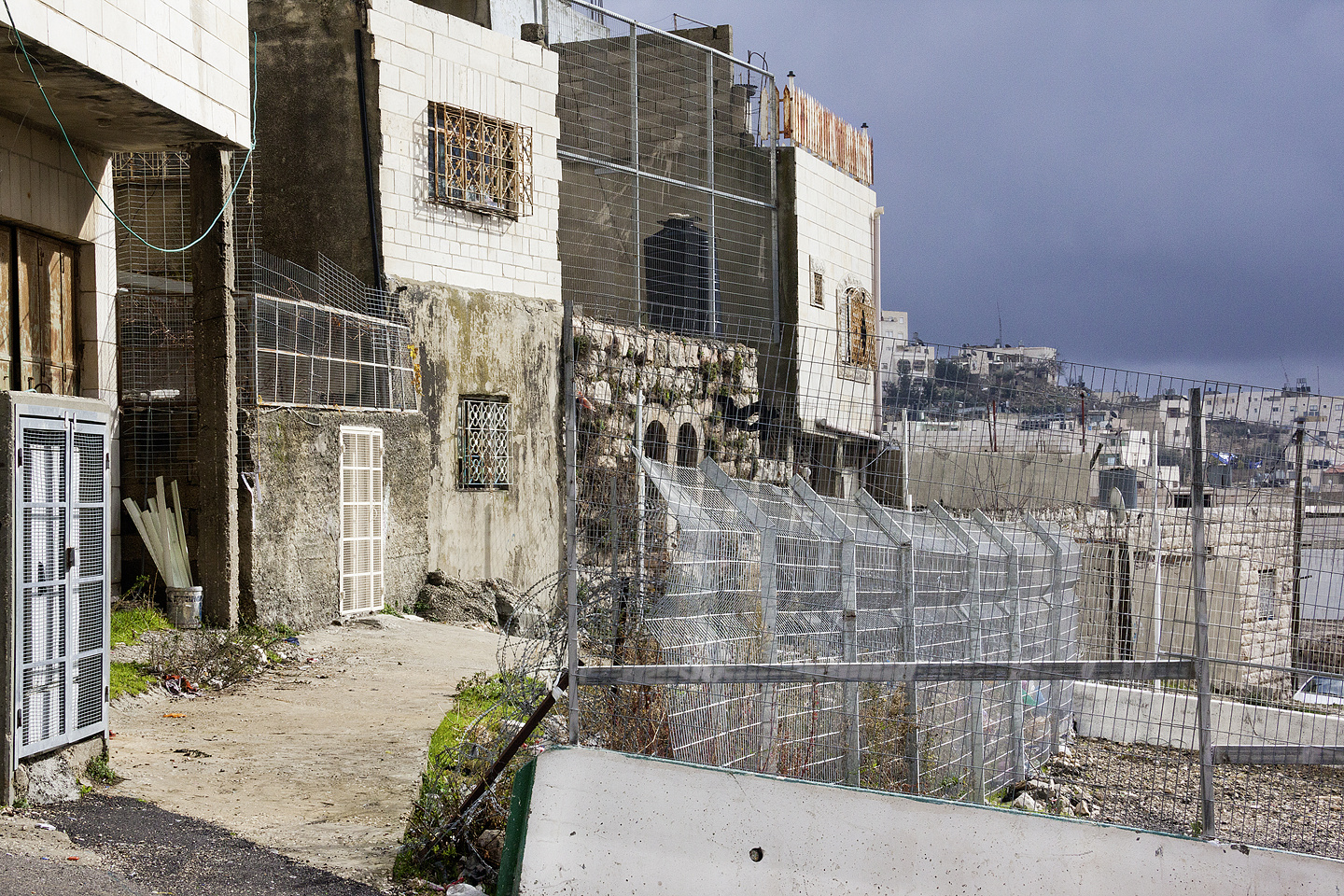
Untitled (Occupation no. 29), al-Khalil, Palestine (2016–17), chromogenic print, 40 × 60 cm. Bani Salim Street, al-Salaimeh neighborhood, Old Town, al-Khalil, January 27, 2017
Close to the checkpoint on the corner of Bani Salim Street and al-Mahawer Street separating the al-Salaimeh neighborhood from the Old Town. The families installed several metal grids to protect themselves from stones and objects thrown on them by settlers who pass by on their way to Me’arat ha-Makhpela (Cave of the Patriarchs). Palestinians are prohibited from traveling by car on this street.
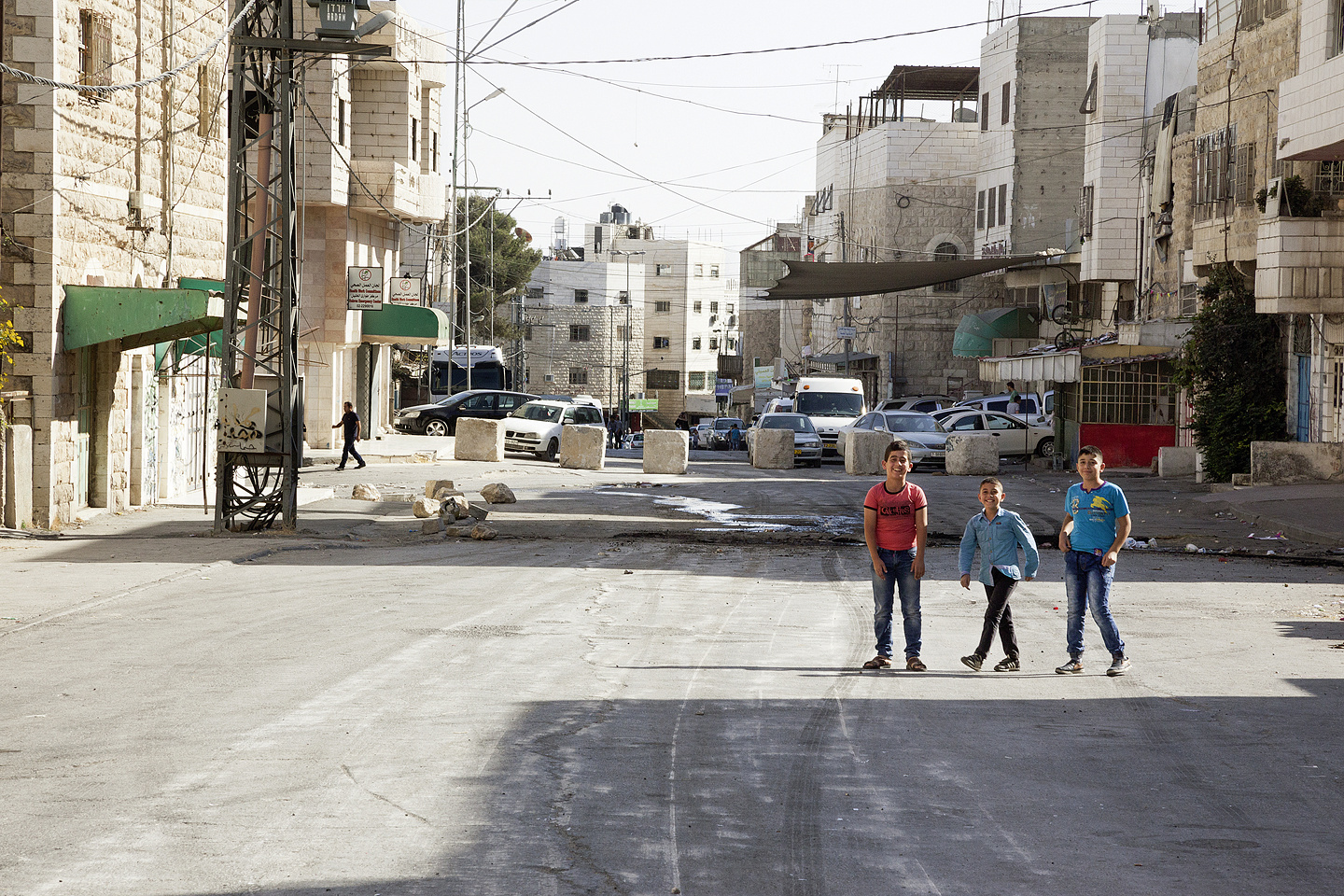
Untitled (Occupation no. 30), al-Khalil, Palestine (2016–17), chromogenic print, 100 × 150 cm. Al-Sahleh Street, al-Qaitoun neighborhood, Old Town, al-Khalil, October 20, 2016
The Abu al-Rish checkpoint located in al-Sahleh Street, south of al-Haram al-Ibrahimi (Abraham’s Mosque/Cave of the Patriarchs), is named after the Abu al-Rish mosque and shrine next to it. The checkpoint separates the Abu Sunaina and al-Qaitoun neighborhoods from the neighborhoods of the Old Town. It also separates the neighborhood from the oldest school in al-Khalil, the al-Ibrahimeyeh School, and from al-Hajariya Girls School. Palestinians are allowed to pass only on foot. The infrastructure of the checkpoint was expanded in July 2016, and since it reopened the IDF have prohibited Palestinians between the ages of sixteen and thirty-four from passing.